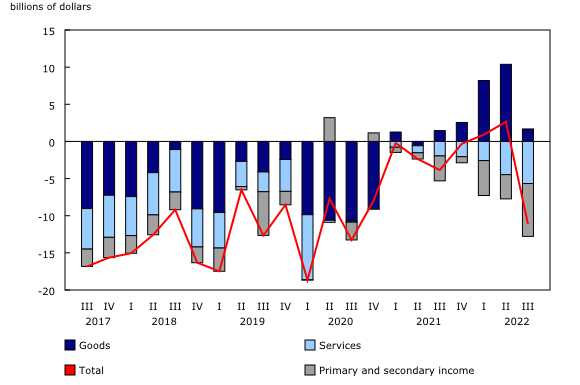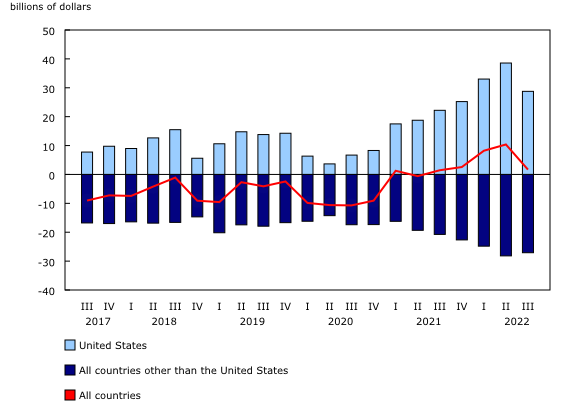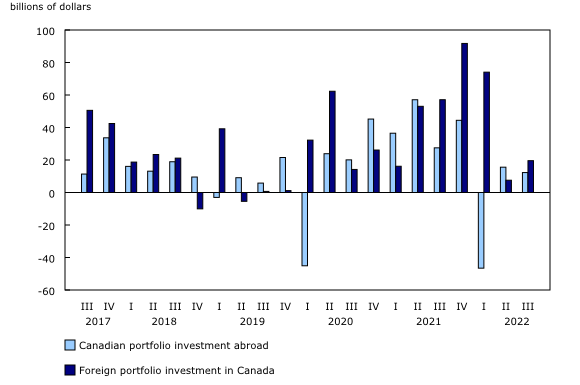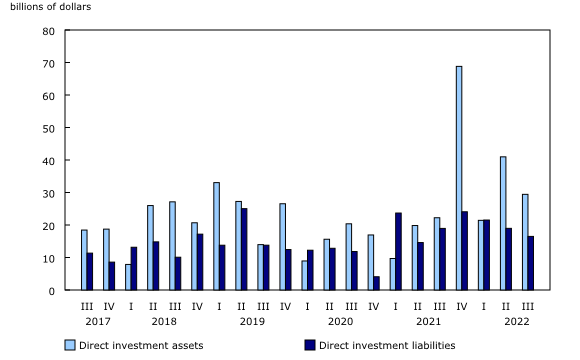Canada's balance of international payments, third quarter 2022
Released: 2022-11-28
-$11.1 billion
Third quarter 2022
Canada's current account balance (on a seasonally adjusted basis) recorded a deficit of $11.1 billion in the third quarter, following surpluses in the first two quarters of 2022. This deficit mainly reflected a considerably lower goods surplus and a higher investment income deficit.
In the financial account (unadjusted for seasonal variation), inflows of funds from abroad to finance the current account deficit came mainly from transactions in currency and deposits, as non-residents increased their holdings of these assets in Canada by $39.0 billion in the third quarter. Portfolio investment was also a contributor, led by foreign investment in Canadian bonds.
Meanwhile, direct investment abroad exceeded direct investment in Canada, resulting in a net outflow of funds totalling $12.9 billion. Both direct investment abroad and direct investment in Canada declined in the third quarter, on lower mergers and acquisitions activity.
Trends of important indicators continued in the third quarter. Notably, interest rates increased, global equity markets declined, and the Canadian dollar appreciated against major foreign currencies, except the US dollar.
Current account
The trade in goods and services posts a deficit
The trade in goods and services balance went from a $5.9 billion surplus in the second quarter to a $4.0 billion deficit in the third quarter, a first deficit in a year. Lower exports of goods largely contributed to this change.
Exports of goods were down by $7.0 billion to $197.0 billion in the third quarter. Despite record-high volumes, exports of energy products were down by $4.2 billion due to a 16.1% decline in prices. This was the first decrease in exports of energy products since the second quarter of 2020. Consumer goods also contributed to the decline in overall exports, down by $2.3 billion in the third quarter of 2022 on lower volumes following a strong second quarter.
Imports of goods rose by $1.7 billion to reach $195.3 billion in the third quarter. The largest gains were in motor vehicles and parts for which imports increased by $1.4 billion on higher prices and volumes.
On a geographical basis, the goods surplus with the United States was down by $9.8 billion to $28.8 billion in the third quarter, with exports decreasing by $7.3 billion. The deficit with countries other than the United States narrowed by $1.1 billion, led by improved trade balances with Hong Kong and Switzerland.
The trade in services deficit rose by $1.2 billion to reach $5.7 billion in the third quarter, a seventh consecutive quarterly increase. The travel balance deteriorated by $1.4 billion as Canadian travellers increased their expenses abroad by $2.2 billion, mostly in the United States. Commercial services deficit edged up by $0.2 billion, mainly on lower exports of financial services. On the other hand, the transport deficit narrowed by $0.5 billion. Imports of sea transport were down after reaching a high in the second quarter.
Higher deficit for investment income
The investment income deficit was up by $3.0 billion to $4.2 billion in the third quarter, in the context of rising interest rates. Overall, income payments were up by more than receipts.
Earnings of foreign investors on their holdings of Canadian securities increased by $2.4 billion to a record-high $20.3 billion, on higher payments of both interests and dividends. Income earned by Canadian investors on their holdings of foreign securities was also up but to a lesser extent.
Profits earned by direct foreign investors in Canada were up $0.8 billion to $18.7 billion. At the same time, profits earned by Canadian direct investors abroad were down, leading to a lower surplus on direct investment income.
Income on deposits and loans, both in Canada and abroad, were also up in the third quarter, with receipts increasing by more than payments. This was mostly related to Canadian banks' international activities.
Financial account
Foreign investment in Canadian securities rises
Foreign investors acquired $19.6 billion of Canadian securities in the third quarter, up from $7.6 billion in the second quarter. Foreign investors acquired Canadian bonds but reduced their exposure to money market instruments and equities in the third quarter.
More precisely, foreign investors purchased $34.9 billion of Canadian bonds in the quarter, predominantly corporate bonds. The reduction in foreign holdings of Canadian equity securities totalled $10.1 billion in the third quarter after a considerable divestment of $14.4 billion in the previous quarter. The foreign divestment was mainly in shares of the manufacturing and the management of companies and enterprises industries. Canadian share prices were down by 4.0% in the third quarter.
On the other side of the ledger, Canadian investors acquired $12.3 billion of foreign securities in the third quarter, a second consecutive quarter of acquisitions following a record-high divestment of $46.6 billion in the first quarter.
Canadian investors continued their acquisitions of foreign bonds in the third quarter, adding $17.5 billion to their portfolios, the largest investment since the second quarter of 2021. However, they reduced their holdings of foreign shares by $3.9 billion in the third quarter of 2022, mainly US shares. Over the third quarter, US share prices fell by 7.8%.
Direct investment slows
Direct investment abroad was $29.4 billion in the third quarter compared with $41.0 billion in the second quarter. Activity in the third quarter mainly reflected earnings reinvested by Canadian parents in their existing foreign affiliates. Meanwhile, mergers and acquisitions activity slowed to $6.8 billion, from $13.7 billion in the second quarter. On a sector basis, the largest share of the investment abroad was in affiliates of the finance and insurance industry.
Direct investment in Canada totalled $16.5 billion in the third quarter, down from $19.0 billion in the second quarter. The manufacturing sector was the main recipient of the investment. On a country basis, foreign direct investment from the United States, the Netherlands, and Switzerland accounted for nearly three-quarters of the quarterly flows. Mergers and acquisitions activity slowed to $1.5 billion, the lowest level since the first quarter of 2019.
Note to readers
Revisions
This release incorporates statistical revisions back to 2019 as part of the annual revision exercise of the Canadian System of Macroeconomic Accounts. Revisions reflect, in large part, the integration of benchmark survey data and updates resulting from the integration of trade data in the broader analytical context of the supply-use tables.
Revisions also reflect the integration of new data sources as well as updates to coverage and statistical methods, including the introduction of updated seasonal factors contributing to revisions to quarterly figures and patterns.
Exports and imports of services were revised upward from 2019. In addition to the typical integration of new benchmark survey data, the coverage of enterprises in the digital economy continued to be enhanced, as was coverage of imports of digital products and services. Notably, starting from reference year 2020, estimates on the value of digital services purchased by Canadian households have been refined through the use of new administrative data. Revisions were mostly related to audio and video streaming (included in audiovisual services) and downloaded software activities (part of computer services). Also, starting with reference year 2020, the coverage of imports of advertising services has been expanded significantly to better capture the extent of Canadian payments to foreign entities for online advertising made on social media, Internet browsers, etc.
Overall, the impact of these updates led to lower current account deficit in 2019. For 2020 and 2021, revisions to payments were higher than for receipts, resulting in current account deficits recorded for all quarters of both years.
Definitions
The balance of international payments covers all economic transactions between Canadian residents and non-residents in three accounts: the current account, the capital account and the financial account.
The current account covers transactions in goods, services, compensation of employees, investment income and secondary income (current transfers).
The current account data in this release are seasonally adjusted. For information on seasonal adjustment, see Seasonally adjusted data—Frequently asked questions.
The capital account covers capital transfers and transactions in non-produced, non-financial assets.
The financial account covers transactions in financial assets and liabilities.
In principle, a net lending (+) or net borrowing (-) derived from the sum of the current and capital accounts corresponds to a net lending (+) or net borrowing (-) derived from the financial account. In practice, as data are compiled from multiple sources, this is rarely the case and gives rise to measurement error. The discrepancy (net errors and omissions) is the unobserved net inflow or outflow.
Foreign direct investment is presented on an asset-liability principle basis (that is, gross basis) in the financial account. Foreign direct investment can also be presented on a directional principle basis (that is, net basis), as shown in supplementary foreign direct investment tables 36-10-0025-01, 36-10-0026-01, 36-10-0473-01 and 36-10-0656-01. The difference between the two foreign direct investment conceptual presentations resides in the classification of reverse investment such as (1) Canadian affiliates' claims on foreign parents and (2) Canadian parents' liabilities to foreign affiliates. Under the asset-liability presentation, (1) is classified as an asset and included in direct investment assets, also referred to as direct investment abroad in this text, and (2) is classified as a liability and included in direct investment liability, also referred to as direct investment in Canada in this text.
For more information on the balance of payments, consult "Chapter 8. International Accounts," in the User Guide: Canadian System of Macroeconomic Accounts, available on Statistics Canada's website. The chapter also presents the most recent balance of payments statistics.
Real-time table
Real-time table 36-10-0042-01 will be updated on December 5. For more information, see Real-time tables.
Next release
Balance of international payments data for the fourth quarter will be released on February 27, 2023.
Products
The product Canada's international trade and investment country fact sheet (71-607-X) is available online. This product provides easy and centralized access to Canada's international trade and investment statistics, on a country-by-country basis. It contains annual information for nearly 250 trading partners in summary form, including charts, tables and a short analysis that can also be exported in PDF format.
The product Canada and the World Statistics Hub (13-609-X) is available online. This product illustrates the nature and extent of Canada's economic and financial relationship with the world using interactive graphs and tables. This product provides easy access to information on trade, investment, employment and travel between Canada and a number of countries, including the United States, the United Kingdom, Mexico, China and Japan.
The Economic accounts statistics and International trade statistics portals are available from the Subjects module of the Statistics Canada website.
The product Methodology for Exports of Energy Products within the International Merchandise Trade Program, which is part of Latest Developments in the Canadian Economic Accounts (13-605-X), is available.
The Methodological Guide: Canadian System of Macroeconomic Accounts (13-607-X) is available.
The User Guide: Canadian System of Macroeconomic Accounts (13-606-G) is also available.
Contact information
For more information, or to enquire about the concepts, methods or data quality of this release, contact us (toll-free 1-800-263-1136; 514-283-8300; infostats@statcan.gc.ca) or Media Relations (statcan.mediahotline-ligneinfomedias.statcan@statcan.gc.ca).
- Date modified:




